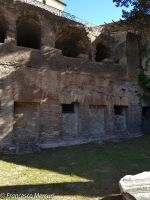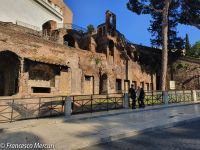Near the Vittoriano monument we can still see the rests of a Roman insula. “Insula”, in Ancient Rome, was the name of buildings with many levels inside of which there were different housing units, very similar to our apartments. This building, very well preserved, survived the demolition process of the 1930s in the area next to the Capitoline hill. Actually, it came to light through the 1930s and the following decade.
The building, made in bricks (some insulae, even if rarely, were made in wood), was probably developed on at least 5 levels and was made allegedly at the beginning of the 2nd century C.E. (maybe under Trajan’s empire). Of this five levels, just the first three have almost completely survived, while we have just a few traces of the fourth. It’s hard to say how tall the structure was, but if we consider that the first two floors are almost 9 metres under the present road surface, we can say that it was a very tall building and that it probably touched 24 metres in height. It’s good to remind that the insula format started to spread from the beginning of the 1st century C.E., when the Urbis population started to grow pretty quickly; during Septimius Severus, between the end of the 2nd century and the beginning of the 3rd century C.E., in Rome there were more than 46.600 insulae, while domus (aristocratic residences) were less than 1.800. This upwards development of buildings was essential to meet middle-low classes necessities. However, this brought to the construction of buildings so tall that the emperor Octavian Augustus had to set a limit for their height: 21 metres. One century after, the emperor Trajan even lowered it to 18 metres. But, why a limit on height? The answer to this question is given by the frequency with which fires broke out: it was very difficult to bring help and contain the blaze in the upper floors of these buildings. It should be taken into consideration, however, that these laws were easily circumvented; just think about the “insula felicles”, a majestic building that in the 2nd century C.E. became famous in all the provinces of the empire. What a shame that we don’t know how tall it was! Our insula, just like any, had a first floor with taverns, storage rooms and shops of different kinds. From the second to the last floor there were houses; we can still see very thick walls and openings for large rectangular windows. The higher you went, the smaller the apartments, the lower the position in society. The reason behind this is that, since lifts did not exist, people with enough economical means preferred to stay lower. For this reason, the rent was lower and lower as going upwards. This makes us understand how Romans conceived rent. Our insula, with its medium-large dimensions, could accommodate 380 people circa. During the High Middle Ages, after the Roman Empire fell, a church was built on the remains of this insula: the church of Saint Blaise of the Market. Near the insula, indeed, there was a market used until the 15th century. The only visible details of the church are a bell tower and a fresco representing Jesus’s deposition in the presence of Virgin Mary and Saint John. On this church was built another one, in baroque style, dedicated to Saint Rita of Cascia, designed by Carlo Fontana. This church, because of the 1930s restorations in the zone, has been disassembled and reassembled in another location pretty close to the original one. Its removal brought to the light the Roman building we can see today. It’s always striking to stop and admire it among the tourists that just pass by without noticing it. Looking down (it is possible, indeed, to see its first floor) and noticing how much the road surface has risen through the centuries, not only we can perceive the real dimensions of these giants of archaeology, but we can also see how many times Rome has been rebuilt. However, our insula’s window to the past is one from which is always nice to look.
Giuseppe Rosselli













































